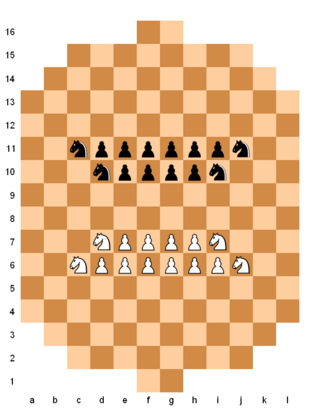
Sternhalma, commonly known as Chinese checkers or Chinese chequers, is a strategy board game of German origin that can be played by two, three, four, or six people, playing individually or with partners. The game is a modern and simplified variation of the game Halma.

Ludo is a strategy board game for two to four players, in which the players race their four tokens from start to finish according to the rolls of a single die. Like other cross and circle games, Ludo is derived from the Indian game Pachisi. The game and its variations are popular in many countries and under various names.

A chess piece, or chessman, is a game piece that is placed on a chessboard to play the game of chess. It can be either white or black, and it can be one of six types: king, queen, rook, bishop, knight, or pawn.

Connect Four is a game in which the players choose a color and then take turns dropping colored tokens into a six-row, seven-column vertically suspended grid. The pieces fall straight down, occupying the lowest available space within the column. The objective of the game is to be the first to form a horizontal, vertical, or diagonal line of four of one's own tokens. It is therefore a type of M,n,k-game with restricted piece placement. Connect Four is a solved game. The first player can always win by playing the right moves.
Martian Chess is an abstract strategy game for two or four players invented by Andrew Looney in 1999. It is played with Icehouse pyramids on a chessboard. To play with a number of players other than two or four, a non-Euclidean surface can be tiled to produce a board of the required size, allowing up to six players.
In tabletop games and video games, game mechanics are the rules or ludemes that govern and guide the player's actions, as well as the game's response to them. A rule is an instruction on how to play, a ludeme is an element of play like the L-shaped move of the knight in chess. A game's mechanics thus effectively specify how the game will work for the people who play it.

Jungle or dou shou qi is a modern Chinese board game with an obscure history. A British version known as "Jungle King" was sold in the 1960s by the John Waddington company. The game is played on a 7×9 board and is popular with children in the Far East.

Uckers is a board game for two to four players traditionally played in the Royal Navy. It has spread to many of the other arms of the UK Armed Forces as well, including the Commonwealth Forces. It can now commonly be found in the Royal Marines, Army Air Corps, Royal Canadian Navy, Royal New Zealand Navy, Royal Australian Navy, Royal Australian Air Force (RAAF), Royal Dutch Navy, and the Royal Air Force (RAF).

Gess is an abstract strategy board game for two players, involving a grid board and mutating pieces. The name was chosen as a conflation of "chess" and "Go". It is pronounced with a hard "g" as in "Go", and is thus homophonous with "guess".

Sáhkku is a board game of the Sami people. The game is traditional among the North Sámi, Skolt Sámi, Inari Sámi and Lule Sámi but may also have been played in other parts of Sápmi.

Aeroplane chess is a Chinese cross-and-circle board game similar to the Western game of Ludo and the Indian game of Pachisi. Developed in the 20th century, aeroplane chess features airplanes as pieces instead of the more abstract pawns and beehive-shaped pieces found in the games from which it is derived. Aeroplane chess has spread around the world, especially in Africa.

Camelot is a strategy board game for two players. It was invented by George S. Parker late in the 19th century, and was one of the first games published by Parker Brothers, originally under the name Chivalry.

TZAAR is the seventh game released in the GIPF series and Games Magazine's 2009 Game of the Year. It officially replaced TAMSK, which was originally published as the second board game in the GIPF Project.

Russian draughts is a variant of draughts (checkers) played in Russia and some parts of the former USSR, as well as parts of Eastern Europe and Israel.

A game is a structured type of play, usually undertaken for entertainment or fun, and sometimes used as an educational tool. Many games are also considered to be work or art.
This glossary of board games explains commonly used terms in board games, in alphabetical order. For a list of board games, see List of board games; for terms specific to chess, see Glossary of chess; for terms specific to chess problems, see Glossary of chess problems.
Pacru is an abstract board game invented by Mike Wellman. Pacru has much in common with Chess and Go (game). Pacru can be played by 2,3 or 4 people, each controlling a single colour. Commercial versions will usually come with the rules for two other games that can be played with the same equipment, Azacru and Shacru. Pacru, Azacru and Shacru have all been featured at the Mind Sports Olympiad.
Hexagony is an abstract strategy board game for 2 to 6 players that was published as Bin'Fa by Taoist Arts Inc. in 1977, as Hexagony by Avalon Hill in 1980, and later re-released in a slightly modified form by Kenterprises as Bin'Fa.

Exorbitare, also known as Quantum Jump, is an abstract board game published by Orca Games in 1981.














